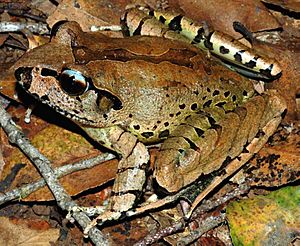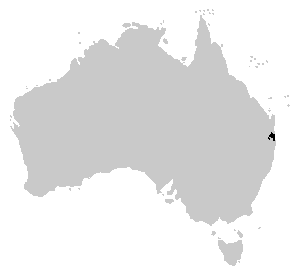Fleay's barred frog facts for kids
Quick facts for kids Fleay's barred frog |
|
|---|---|
 |
|
| Conservation status | |
| Scientific classification | |
| Genus: |
Mixophyes
|
| Species: |
fleayi
|
 |
|
| Fleay's barred frog range | |
The Fleay's barred frog (Mixophyes fleayi) is a large type of frog. You can only find it in small areas of rainforest in northern New South Wales and south-eastern Queensland, Australia.
Contents
Where Fleay's Barred Frog Lives
This frog lives in different wet forest areas. You can find it from the Conondale Range in Queensland in the north, down to Yabbra Scrub in northern New South Wales in the south. Most of these frogs live in rainforests that are higher than 400 meters (about 1,300 feet) above sea level. However, some also live in rainforests closer to sea level.
Since the 1970s, the number of these frogs has gone down in many places in Queensland. Today, they are found in places like Conondale, Main Range, Springbrook, Lamington Plateaux, and Mount Barney in Queensland. In New South Wales, they live in the Border Ranges, Mount Warning, Nightcap Range, and Yabbra and Tooloom Scrub. They used to live in an area of about 7,000 square kilometers (about 2,700 square miles). Sadly, they have completely disappeared from Bunya Mountains and Mount Tamborine in Queensland.
What Fleay's Barred Frog Looks Like
Fleay's barred frog is a pretty big frog, growing up to 90 millimeters (about 3.5 inches) long. Its skin is light brown with darker patches and feels a bit bumpy on its back. It has a dark brown band that isn't perfectly straight, starting behind its eyes and going down its back. A dark stripe runs from its nose, through its eye, to its eardrum area (called the tympanum).
Its arms and legs have about 7 to 8 thin, dark stripes. The sides of its body have scattered dark spots and blotches. The top part of its eye is shiny silver or light blue, while the bottom part is brown. Its upper lip has brown spots. The frog's belly is smooth and is usually pale yellow or white. Its toes are about three-quarters webbed, which helps it swim. This frog was named after Australian naturalist David Fleay.
Fleay's Barred Frog Behaviour and Life Cycle
This frog likes to live near flowing streams and creeks. You can find them in rainforests, wet eucalyptus forests, and Antarctic Beech forests. After it rains during spring and summer, male frogs make a "ok-ok-ok-ok-ok" or "arrrrk" sound. They usually call from the leaves on the ground next to the streams.
Female frogs lay their eggs in a special nest they dig in gravel and leaves in shallow, moving water. The tadpoles are quite large, growing up to 65 millimeters (about 2.5 inches) long. It takes about 200 days for a tadpole to change into a frog. When they first change, they are about 20 millimeters (less than an inch) long. They look like adult frogs, but their eyes are a copper-red color instead of silver-blue.
It has been hard to figure out how much the number of these frogs has gone down. This is because there aren't many old records of where they lived or how many there were.
Frogs That Look Similar
Fleay's barred frog looks a lot like other frogs in the Mixophyes family. It is especially similar to the stuttering frog (Mixophyes balbus). The only way to tell them apart is by looking for spotted patterns on the sides of Fleay's barred frog.
The great barred frog (Mixophyes fasciolatus) and the giant barred frog (Mixophyes iterauts) also live in the same areas. The best way to tell these three species apart is by their eye color, as each one has a different eye color.
Protecting Fleay's Barred Frog
Fleay's barred frog is listed as Endangered. This means it is at a very high risk of disappearing forever. It is listed as endangered by both the IUCN Red List (a worldwide list of threatened species) and Queensland's Nature Conservation Act 1992 (a law in Queensland, Australia).
See also
 In Spanish: Mixophyes fleayi para niños
In Spanish: Mixophyes fleayi para niños
Images for kids


